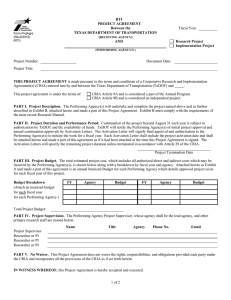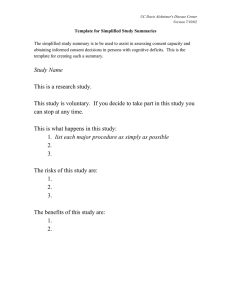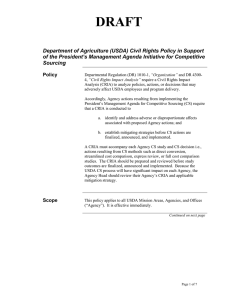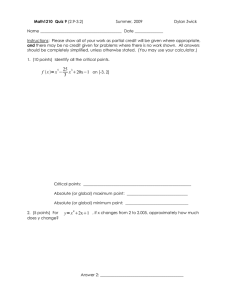Document 13438483
advertisement
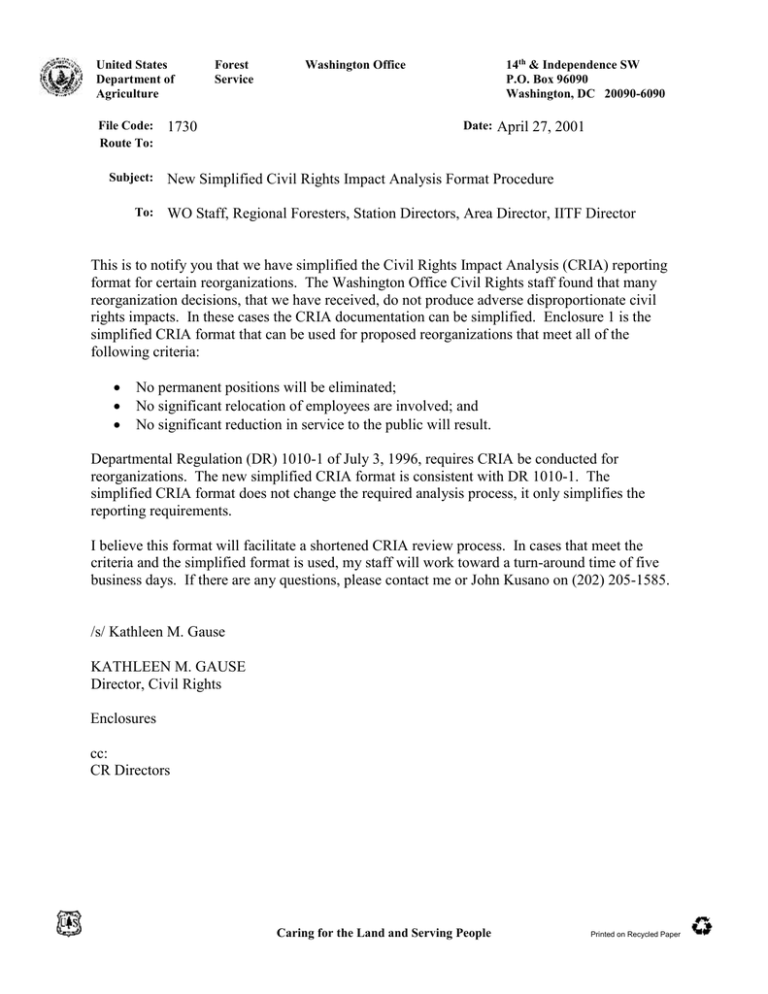
United States Department of Agriculture File Code: Route To: Subject: To: Forest Service 1730 14th & Independence SW P.O. Box 96090 Washington, DC 20090-6090 Washington Office Date: April 27, 2001 New Simplified Civil Rights Impact Analysis Format Procedure WO Staff, Regional Foresters, Station Directors, Area Director, IITF Director This is to notify you that we have simplified the Civil Rights Impact Analysis (CRIA) reporting format for certain reorganizations. The Washington Office Civil Rights staff found that many reorganization decisions, that we have received, do not produce adverse disproportionate civil rights impacts. In these cases the CRIA documentation can be simplified. Enclosure 1 is the simplified CRIA format that can be used for proposed reorganizations that meet all of the following criteria: No permanent positions will be eliminated; No significant relocation of employees are involved; and No significant reduction in service to the public will result. Departmental Regulation (DR) 1010-1 of July 3, 1996, requires CRIA be conducted for reorganizations. The new simplified CRIA format is consistent with DR 1010-1. The simplified CRIA format does not change the required analysis process, it only simplifies the reporting requirements. I believe this format will facilitate a shortened CRIA review process. In cases that meet the criteria and the simplified format is used, my staff will work toward a turn-around time of five business days. If there are any questions, please contact me or John Kusano on (202) 205-1585. /s/ Kathleen M. Gause KATHLEEN M. GAUSE Director, Civil Rights Enclosures cc: CR Directors Caring for the Land and Serving People Printed on Recycled Paper ENCLOSURE (1) CRIA FORMAT FOR SIMPLE UNIT REORGANIZATIONS 1. Proposed Action [Describe the management environment and proposal's goals, objectives, operations, issues, opportunities, scope and duration of decision.] 2. Civil Rights Impacts of the Proposed Action [Based on an analysis of applicable Civil Rights variables (refer to Enclosure 2), determine and document adverse disproportionate impacts of the proposed action. If multiple alternative actions are being proposed, describe each of the alternative proposals, including a no change alternative.] 3. Actions to Reduce Potential Negative Impacts [Identify actions to eliminate and/or mitigate unfavorable, potential civil rights or social impacts of the proposed action.] 4. Recommendations and Monitoring Actions. [Identified a process or plan for monitoring implementation and mitigation measures.] 5. Line Officer [Unit] Approval. [Provide a signature page for unit review(s) and approval(s) of the unit reorganization proposal by the line officer.] 6. Certification of [Unit] Civil Rights Director. [Certification statement (below) that Agency/unit CR Director was actively involved in the planning and implementation of unit reorganization proposals from the civil rights perspective.] CERTIFICATION of CIVIL RIGHTS DIRECTOR As the agency’s principal Equal Employment Opportunity (EEO) official, the Director of Civil Rights (CR) is responsible for administering a full range of EEO and Title VI Programs. The Director provides advice and technical guidance on CR matters to the USDA Forest Service [TITLE, UNIT LINE OFFICER, RESPONSIBLE OFFICIAL] and other Agency management officals. This is certification that the Director of CR was actively involved in the planning and implementation of this reorganization proposal. ______[SIGNATURE REQUIRED]___________________ [NAME] Director, Civil Rights [UNIT NAME] ENCLOSURE (2) Page 1 Potential Civil Rights Variables This is a list of potential CR variables to be considered, as applicable, in analyzing Civil Rights Impacts of the proposed action. 1. Quality of the work environment. a. Size, number, and characteristics of existing ethnic and occupational cultures, including people with disabilities. b. Degree of job autonomy; supervisor/employee and other relationships. c. Satisfaction with organizational climate. d. Career advancement patterns. e. Relationships with labor organizations, employee groups, and other partners. 2. Attitudes, beliefs, and values. a. Public and employee perceptions of Forest Service goals/mission. b. Scope and intensity of demonstrated support and/or opposition to the proposed action. c. Customs and traditions in the affected area. d. Cultural orientations toward certain actions. e. Perceptions of and about women, minorities, and persons with disabilities. f. Supervisor and/or employee past behavior toward civil rights and/or affirmative employment and recruitment. 3. Social organization. a. Community and/or unit cohesion (degree of unity and cooperation). b. Community and/or unit stability (ability to absorb and manage change). c. Source and focus of leadership (both formal and informal). d. Family and friendship networks. e. Traditions of mutual trust and aid. f. Symptoms of stress and anxiety. ENCLOSURE (2) Page 2 Potential Civil Rights Variables Social Organization (cont) g. Type, diversity, and membership of service and special interest organizations. h. Opportunities for effective participation (both by public and employees), for example, contracts and grants, cooperative agreements, partnerships, and management decision making input. 4. Workforce characteristics. a. Racial and ethnic composition of affected unit and locale. b. Attrition rates (normal and otherwise). c. Available human resources (educational level, talents, and skills) in-service and in the geographical area. d. Promotion and tenure patterns. e. Age and gender characteristics. f. Workforce diversity by series and grade. g. Individual development plans and training.

